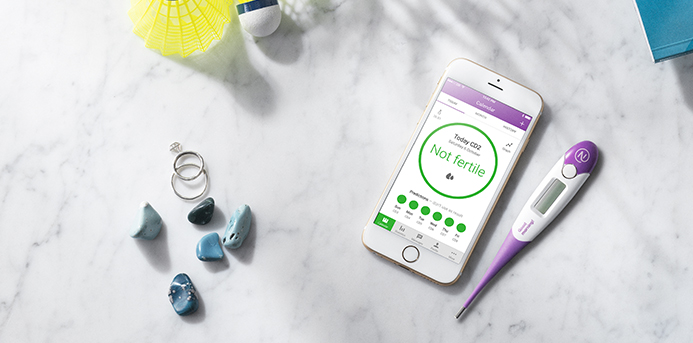In mid-August, the Food and Drug Administration (FDA) approved a mobile device app named “Natural Cycles” for contraceptive use. Just last year, the FDA released a “Digital Health Innovation Action Plan” to look at ways to provide clarity and find efficiency in how the agency regulates digital health technologies, and this is the first time the FDA has identified and specifically approved an app as a contraceptive.
The approval raises a lot of questions about the reliability of digital tracking methods and who this type of pregnancy prevention is best suited for. We looked at the research and spoke to several doctors of Obstetrics and Gynecology (OB-GYN) for their opinions. Here’s what you need to know.
How Does It Work?
The app is sort of like fertility tracking in reverse — instead of recording information when trying to conceive to discover your most fertile days to have sex while ovulating (as with the classic rhythm method), you’re revealing the best days to avoid sex, and thus avoid getting pregnant. The female user records her basal temperature first thing in the morning for at least five days a week and enters her menstrual cycle information into the interface; the app combines this data with its proprietary algorithm to predict which days are safe for sexual intercourse. Those days get a green signal while days with a high potential of pregnancy earn a red signal. On red signal days, users must either abstain from sex or use an alternate form of birth control, like condoms, to avoid getting pregnant.
However, Dr. Sri Reddy, OB-GYN at Harvard Vanguard in Cambridge, Massachusetts, notes that, “There are so many reasons a temperature can have variations — drinking coffee or tea, a hot day, or simply feeling under the weather. Temperatures are not the most helpful measure for predicting fertility windows.”
Natural Cycles’ website counters this argument by noting that if temperature readings are irregular or inconsistent, the algorithm will give the user more red days and that it takes about three months for the algorithm to begin to predict with accuracy. For the first few months, users will experience an increased number of red days, which will decrease as the app gathers data and is better able to forecast safe days. Of course, routinely entering information into the app is key — and this is exactly what gives another OB-GYN pause.
Dr. Tanner Colegrove, medical director in the OB Hospitalist Program at Illinois’ Northwestern Medicine Lake Forest Hospital, says “Human compliance is where I think this method has a huge potential to fail. There are basically two levels of compliance here — first the daily temperature and period tracking, then, by the way, don’t forget to use an alternate method of birth control on days indicated by the app. At the heart of it, the most crucial point is not having sex on red days, which relies on willpower, and willpower is faulty. Maybe you want to have sex because it’s a special occasion or a big night out, or a vacation — this app requires all of that tracking compliance plus the willpower to either not have sex or the advance planning and preparation to have it. The compliance issue brings down efficacy of other methods as well, but the app adds an extra layer.”
So How Reliable is It?
In terms of reliability, Natural Cycles falls in line with more mainstream methods. Specifically, it shows a 93 percent effectiveness in controlled research studies. According to Planned Parenthood, birth control pills are 91 percent effective at preventing pregnancy, condoms are 85 percent effective, and diaphragms are 88 percent effective. By far the highest prevention success rates are seen with IUDs and birth control implants, which are most reliable with a 99 percent effectiveness rate.
According to the Natural Cycles website, “When calculating typical use effectiveness in the study, all possible reasons for becoming pregnant while using the app were taken into account: from having unprotected sex on a red day to the app wrongly attributing a green day or the chosen method of contraception on a red day having failed. The Natural Cycles algorithm has been intricately designed to account for sperm survival, variation in cycle length, ovulation day, and temperature fluctuations. It is sensitive to subtle patterns in your cycle: if it sees something unexpected, it will err on the side of caution and give you a red day.”
Who Should Use It?
Natural Cycles has created a flowchart to guide medical professionals in recommending the app. The chart indicates that the perfect candidate is over 18 years of age and has a regular lifestyle and sleep pattern, as well as a stable partner. The app is not recommended for patients who are comfortable with existing long-acting methods of birth control (like the more reliable IUDs and implants) or for whom pregnancy within one year will be devastating.
Colegrove says, “If all of those questions checked out, I could see recommending the app for a very unique, well educated, type-A, motivated person — but only after I’ve ruled out all other options for them.” It seems as if the ideal patient for the app has a pretty settled lifestyle, which would indicate she is older yet, Colegrove adds, “Anyone who is pushing mid-to-late 40s with irregular cycles would be really difficult to predict non-fertile days for. There is probably a small subset of patients this would work for, but they would have to be carefully selected.”
When asked about recommending the app, Reddy says, “It’s not going harm a patient, but if she really, really doesn’t want to become pregnant, then she needs to be on some other form of birth control. This method could be additive, but I wouldn’t use it as the primary one.”
The apps website adds further stipulations: “Natural Cycles should not be used by women who have a medical condition where pregnancy would be associated with a significant risk to the mother or the fetus or those currently using birth control or hormonal treatments that inhibit ovulation.”
What is the Cost and Availability?
Natural Cycles is available for mobile devices in Android and Apple app stores. There’s a monthly option for $9.99 a month or yearly option for $79.99. According to Planned Parenthood, prices for birth control pills are variable (depending on insurance options), but usually run $0-50 a month, or up to $600 a year. The app could prove to be a more affordable option for the subset of women who meet the ideal criteria.
Final Thoughts
It’s important to note that, unlike some hormone-based methods, the app has no known side effects or health risks. The app also doesn’t provide protection against sexually transmitted diseases (which is why it isn’t recommended for women without stable partners). Lastly, diligence is of utmost importance with this method. These are factors to consider when deciding if the app is a good option for you.
“Consumers are increasingly using digital health technologies to inform their everyday health decisions, and this new app can provide an effective method of contraception if it’s used carefully and correctly,” says Terri Cornelison, M.D., Ph.D., assistant director for the health of women in the FDA’s Center for Devices and Radiological Health, in the FDA’s press release. “But women should know that no form of contraception works perfectly, so an unplanned pregnancy could still result from correct usage of this device.”
With the establishment of approval guidelines and the FDA’s affirmation of Natural Cycles, it’s likely we will see more apps gaining sanction. It remains important to discuss these types of health-related decisions with your medical professional who will help you decide the best method of birth control for your situation.
More from Make It Better:
- The 8 Best Teas For Your Health
- 8 Health Conditions That Could Be Disrupting Your Sleep
- 15 Foods and Diet Choices That Can Reduce Your Breast Cancer Risk
 Pamela Rothbard is a writer and photographer living in Glencoe, Illinois. Her work has appeared in various literary and mainstream magazines and on National Public Radio, and her parenting and baking blog, Flour on the Floor, was featured in Better Homes and Gardens. Pamela has been a regular Make It Better contributor since 2013. When she’s not behind a keyboard or a camera, she’s trying new recipes and restaurants and adding another layer of clothing because she’s always cold. Pamela is also a supporter of no-kill shelters and animal rescue organizations (her favorites are PAWS Chicago and Best Friends in Utah). Find her on Twitter and Instagram @pamelarothbard.
Pamela Rothbard is a writer and photographer living in Glencoe, Illinois. Her work has appeared in various literary and mainstream magazines and on National Public Radio, and her parenting and baking blog, Flour on the Floor, was featured in Better Homes and Gardens. Pamela has been a regular Make It Better contributor since 2013. When she’s not behind a keyboard or a camera, she’s trying new recipes and restaurants and adding another layer of clothing because she’s always cold. Pamela is also a supporter of no-kill shelters and animal rescue organizations (her favorites are PAWS Chicago and Best Friends in Utah). Find her on Twitter and Instagram @pamelarothbard.

